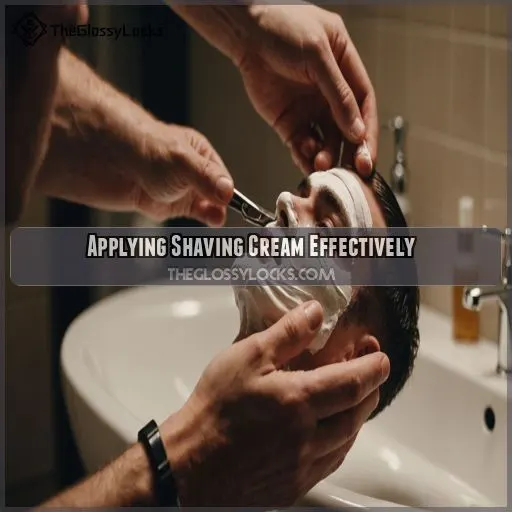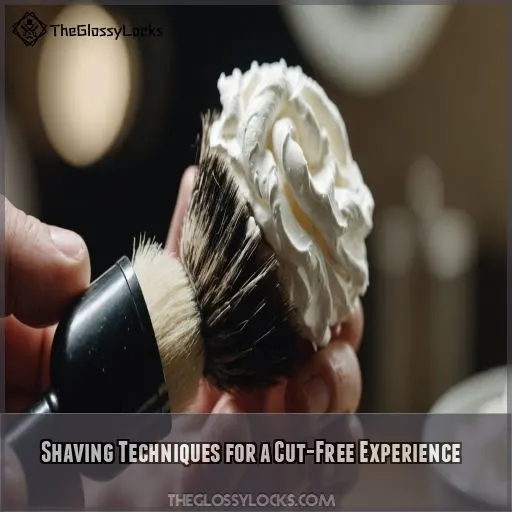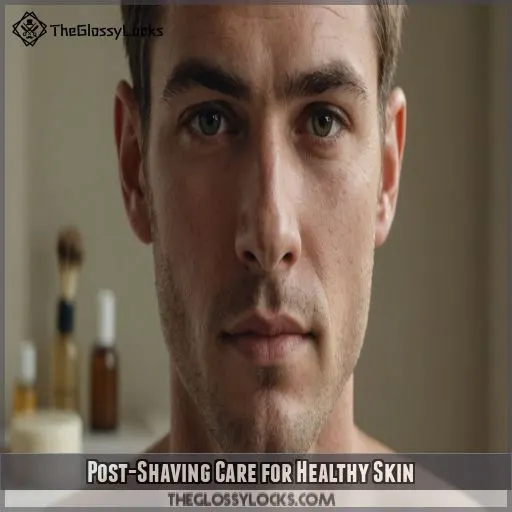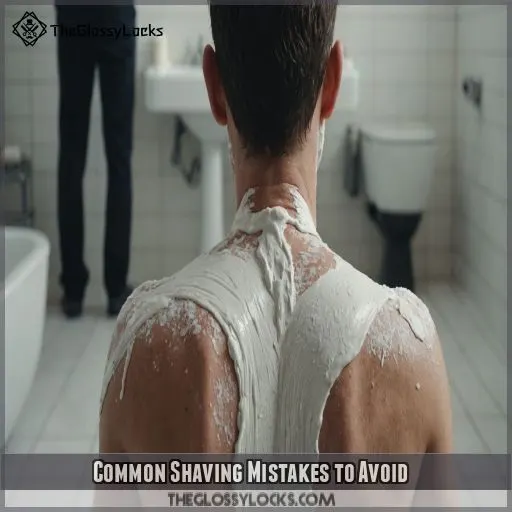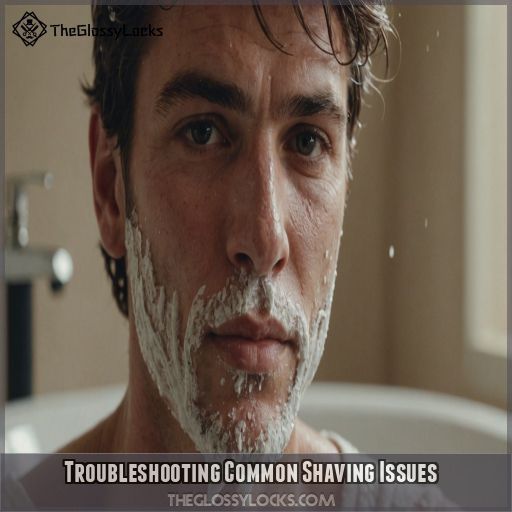This site is supported by our readers. We may earn a commission, at no cost to you, if you purchase through links.
 The art of shaving without sacrificing your skin!
The art of shaving without sacrificing your skin!
To apply shaving cream like a pro and avoid those pesky cuts, start by using a Shaving brush to whip up a rich lather.
Don’t be shy – aim for a thick layer to cushion your skin.
Apply it in quick, circular motions, making sure to cover all areas evenly.
Now, here’s the key: shave with the grain of hair, not against it.
This will reduce irritation and Razor burn.
Table Of Contents
- Key Takeaways
- Before You Shave
- Choosing the Right Shaving Cream
- Applying Shaving Cream Effectively
- Shaving Techniques for a Cut-Free Experience
- Post-Shaving Care for Healthy Skin
- Common Shaving Mistakes to Avoid
- Shaving Cream Vs Gel Vs Foam: What’s the Difference?
- Troubleshooting Common Shaving Issues
- Frequently Asked Questions (FAQs)
- Does shaving cream help prevent cuts?
- How do you prevent skin from cutting when shaving?
- How do you prevent cuts when shaving down there?
- How to properly use shaving cream?
- What is the ideal water temperature for shaving preparation?
- Can I use regular soap instead of shaving cream?
- How often should I change my shaving razor blades?
- Can I shave over the same spot multiple times?
- Are there any benefits to using a shaving brush?
- Conclusion
Key Takeaways
- You’ll want to exfoliate wisely before shaving to remove dead skin cells and help your razor glide smoothly – think of it as prepping the canvas for a masterpiece!
- To avoid those pesky cuts, apply a rich, lubricating shaving cream in an upward motion, making sure to cover all areas evenly – don’t be shy, you want a thick layer to cushion your skin.
- When shaving, go with the flow – literally! Shave with the grain of hair, not against it, to reduce irritation and razor burn, and remember to stretch your skin gently to help the razor glide smoothly.
- After shaving, give your skin some TLC by rinsing with cold water, patting dry with a microfiber towel, and applying a fragrance-free moisturizer to soothe and hydrate your skin – it’s like giving your skin a big hug!
Before You Shave
Preparing your skin is key to avoiding those dreaded cuts and nicks when shaving.
Exfoliating and soaking your skin are essential steps to get your pores open and ready for a smooth shave.
Using a hot towel or shower can help achieve this. Exfoliating with olive oil and brown sugar is also a simple yet effective method.
Pre-Shaving Preparation Tips
Get ready to shave like a pro! Before you start, let’s get your skin prepped. Here are four essential pre-shaving tips to guarantee a smooth ride:
- Exfoliate wisely: Use gentle exfoliating techniques to remove dead skin cells.
- Cleanse the area: Wash your skin with a gentle soap to remove dirt and oils.
- Prepare your razor: Make sure your razor is clean and sharp.
- Use a pre-shave oil: Apply a pre-shave oil to help your razor glide smoothly.
Soaking the Skin to Open Up Pores
Now that you’ve prepped your skin, it’s time to soak it in warm water to open up those pores. Soak for 5 minutes to soften your hair and make shaving a breeze. This step is essential, as it helps the shaving cream penetrate deeper and lift hairs for a smoother shave. Think of it as a mini-spa treatment!
Exfoliating With Olive Oil and Brown Sugar
Before you shave, exfoliate with a mixture of olive oil and brown sugar to remove dead skin cells and help the razor glide smoothly. This sugar scrub benefits your skin by reducing dry, flaky patches and ingrown hairs. Try these alternatives to upgrade your skin care routine:
- Mix 1 tablespoon of brown sugar with 1 tablespoon of olive oil for a gentle exfoliant.
- Use coconut sugar for a coarser texture.
- Add a squeeze of lemon juice for an astringent effect.
- Exfoliate in circular motions to avoid irritating your skin.
- Focus on areas with thick or curly hair for a closer shave.
Preparing the Skin With a Hot Towel or Shower
Now that you’ve exfoliated with olive oil and brown sugar, it’s time to bring out the big guns.
A hot towel or shower is essential in softening your hair and opening up your pores, making it easier for the razor to glide smoothly.
Think of it as a warm hug for your skin, prepping it for a silky shave.
Choosing the Right Shaving Cream
Choosing the right shaving cream is essential to avoiding cuts and nicks, so you’ll want to pick one that’s well-suited to your skin type and needs. Look for ingredients like surfactants, emollients, and lanolin, which work together to create a rich lather that protects and moisturizes your skin as you shave (Source).
Ingredients to Look for in Shaving Cream
Now that you’re prepped for shaving, let’s talk ingredients! Look for natural moisturizers like glycerin, soothing agents like aloe vera, and exfoliating ingredients like alpha-hydroxy acids. Skin conditioners and anti-inflammatory additives can also help. Opt for pH-balanced creams with essential oils like lavender or chamomile. Your skin will thank you for choosing gentle, effective ingredients.
Surfactants and Emollients for Healthy Skin
When choosing a shaving cream, look for natural surfactants and emollients that repair and moisturize your skin. Gentle exfoliants like alpha-hydroxy acids and soothing ingredients like aloe vera can help reduce irritation. Opt for a cream with skin barrier repair properties to keep your skin healthy and resilient. Your skin will thank you for the extra TLC!
Lanolin for Moisturizing Benefits
Now that we’ve covered surfactants and emollients, let’s talk about lanolin – the ultimate moisturizing powerhouse in shaving creams. This natural wonder helps lock in hydration, leaving your skin feeling soft and supple. Look for lanolin-rich shaving creams to give your skin an extra dose of TLC. Your skin will thank you, and so will your razor!
How to Select a Shaving Cream for Sensitive Skin
In the context of sensitive skin, choosing the right shaving cream can be a game-changer. You want a product that soothes, not irritates. Opt for fragrance-free options, soothing skin additives, and natural ingredients that benefit your skin type. Here are some must-haves:
- Fragrance-free or hypoallergenic formulas to minimize irritation
- Soothing ingredients like aloe vera, chamomile, or green tea
- Natural ingredients like coconut oil, shea butter, or olive oil
- Avoid harsh chemicals, dyes, or artificial fragrances
- Opt for a shaving cream specifically designed for sensitive skin
Applying Shaving Cream Effectively
You’re just one step away from a cut-free shaving experience – mastering the art of applying shaving cream effectively. By learning how to use a shaving brush, create a rich lather, and apply a thick layer of cream, you’ll be saying goodbye to those pesky nicks and cuts in no time (Source).
Using a Shaving Brush for a Smooth Application
You’ve picked the perfect shaving cream, now it’s time to bring in the big guns – your trusty shaving brush! A good brush is essential for a luxurious shaving experience. Here’s a quick rundown on brush care and techniques:
| Brush Type | Benefits |
|---|---|
| Badger Hair | Holds heat and water well |
| Boar Hair | Gentle on skin, easy to clean |
| Synthetic Bristle | Affordable, cruelty-free |
| Brush Care Tips | Clean and dry regularly |
Creating a Lather With Quick Strokes
Now that you’ve got your shaving brush loaded with cream, it’s time to create that perfect lather! Use quick strokes to whip the cream into a fluffy, airy consistency – think of it as making whipped cream, but for your face. Move the brush in a circular motion, building up the lather in your shaving bowl until it’s just right.
Applying a Thick Layer of Shaving Cream
It’s time to apply a thick layer of shaving cream.
Use your brush to coat the area evenly, making sure to cover all the skin you plan to shave.
A generous amount of shaving cream will help the razor glide smoothly. It acts as a protective barrier between your skin and the blade.
Shaving With the Grain of Hair
When shaving, go with the flow – literally! Shaving with the grain of hair reduces irritation and razor burn. Here’s how:
- Identify hair growth patterns: Take note of the direction your hair grows.
- Adjust your shaving angle: Shave in the same direction as hair growth.
- Use light strokes: Apply gentle pressure to avoid razor drag.
- Keep a steady hand: Take your time for a smooth shave.
Shaving Techniques for a Cut-Free Experience
You’re just a few strokes away from a cut-free shave – all it takes is mastering the right techniques. By learning how to apply shaving cream effectively and combining it with smart shaving strategies, you’ll be saying goodbye to nicks, cuts, and razor burn in no time.
Using a Single-Blade Razor for a Close Shave
For a close shave, ditch the multi-blade razors and try a single-blade one instead! With fewer blades, there’s less chance of razor burn and ingrown hairs. Plus, it’s gentler on your skin. Just remember to maintain your razor by cleaning it regularly and replacing the blade often to avoid clogging. Happy shaving!
Stretching the Skin for a Smooth Shave
Time to get a little flexible! Stretching your skin while shaving helps the razor glide smoothly, reducing nicks and cuts. Gently pull the skin taut with your fingers, especially around the cheekbones and neck. Relax your facial muscles and adjust your shaving angle to match the contours of your face. Easy does it, smooth shaving ahead!
Avoiding Ingrown Hairs and Razor Burn
The pesky ingrown hairs and razor burn – we’ve all been there! To avoid these unwanted guests, make sure to exfoliate before shaving, use a sharp razor, and shave at a 20-degree angle. Don’t press too hard, and change your razor frequently to prevent irritation.
Here are some extra tips to keep in mind:
- Exfoliate wisely: Use gentle exfoliating techniques to remove dead skin cells and help prevent ingrown hairs.
- Razor burn remedies: Apply a cold compress or aloe vera gel to soothe razor burn and reduce redness.
- Shaving angle is everything: Shave at a 20-degree angle to avoid nicks and cuts.
- Ingrown hair prevention: Avoid using irritating ingredients and dull razors, and take your time while shaving to prevent ingrown hairs.
Shaving in the Direction of Hair Growth
Now that we’ve tackled avoiding ingrown hairs and razor burn, let’s focus on shaving in the direction of hair growth. You see, direction matters! Shaving with the grain (not against it) is key to preventing irritation. For thick, coarse hair, this is especially important. Trust us, your skin will thank you for following its natural hair growth patterns.
Post-Shaving Care for Healthy Skin
You’ve made it through the shaving process without any major mishaps – now it’s time to give your skin some TLC to prevent irritation and keep it healthy.
By following a few simple post-shaving care steps, you can keep your skin looking and feeling its best (Source).
Here’s what you can do:
- Rinse with cold water.
- Pat dry with a microfiber towel.
- Apply fragrance-free moisturizer.
- Use aftershave to close pores.
Rinsing With Cold Water to Reduce Irritation
The sweet relief of a cold water rinse after a shave! It’s like a calming hug for your skin. Cold water helps close those pores, reducing irritation and inflammation. Your barber knows this secret, and now you do too! So, splash on some cold water and reap the benefits of a smoother, healthier post-shave complexion.
Patting Dry With a Microfiber Towel
The final step: drying off without undoing all your hard work!
Gently pat dry with a microfiber towel to reduce irritation and prevent those pesky ingrown hairs.
Avoid rubbing or scrubbing, as this can cause friction and lead to skin sensitivity.
Your skin will thank you for the TLC, and you’ll be one step closer to mastering the art of shaving.
Applying Fragrance-Free Moisturizer
Now that you’ve gently patted dry with a microfiber towel, it’s time to lock in moisture. Apply a fragrance-free moisturizer to soothe and hydrate your skin. Look for a clear, concentrated formulation that’s dermatologist-approved. This simple step will help calm any irritation and leave your skin feeling soft and supple. Your skin will thank you!
Using Aftershave to Close Pores
Now that you’ve applied that fragrance-free moisturizer, it’s time to seal the deal with aftershave! This often-overlooked step can make all the difference in closing those pores and toning your skin.
- Reduces appearance of pores for a smoother finish
- Soothes and calms irritated skin
- Helps balance skin pH for a healthy glow
- Can contain natural ingredients like witch hazel and tea tree oil for added benefits
Common Shaving Mistakes to Avoid
You’re probably making some common shaving mistakes that are causing those pesky cuts and nicks – don’t worry, we’ve all been there!
By avoiding a few key errors, you can say goodbye to those annoying cuts and hello to a smoother, healthier shave.
Some of the most common mistakes include shaving against the grain of hair, using a dull razor blade, not exfoliating before shaving, and not applying enough shaving cream.
Shaving Against the Grain of Hair
Don’t go against the grain – literally! Shaving against the direction of hair growth is a recipe for disaster, leading to razor burn, ingrown hairs, and cuts. Identify the grain by running your fingers over your skin, then shave in the same direction. Your skin will thank you!
| Hair Grain Direction | Shaving Angle Importance | Cut Prevention Tips |
|---|---|---|
| Identify by running fingers over skin | Shave at a 20-degree angle | Exfoliate before shaving |
| Shave in the same direction | Avoid applying too much pressure | Use a sharp razor blade |
| Adjust angle for sensitive areas | Shave with light, gentle strokes | Apply soothing aftershave |
| Use a mirror to visualize grain | Avoid shaving over the same spot | Pat dry with a microfiber towel |
Using a Dull Razor Blade
Using a dull razor blade is a recipe for disaster! In addition to causing more nicks and cuts, it’ll also lead to razor burn and ingrown hairs. To avoid this, change your blade every 5-7 shaves and store it in a dry place. A sharp blade is key to a smooth, safe shave.
Not Exfoliating Before Shaving
Don’t skip exfoliating before shaving! It’s like trying to paint a dirty canvas – you won’t get a smooth finish. Exfoliating techniques help remove dead skin cells, allowing for a closer shave. Try these pre-shave routines:
- Mix brown sugar and olive oil for a gentle scrub
- Use a washcloth to exfoliate hard-to-reach areas
- Exfoliate 1-2 times a week for the best skin clearing results.
Not Applying Enough Shaving Cream
Hey, don’t be stingy with that shaving cream! Not applying enough can lead to a rough shave and razor burn. Make sure to squirt an almond-sized dab into your hands and work it into a rich lather. If you’re using a brush, load it up with a generous amount to cover all areas for a smooth, glide-y shave.
Shaving Cream Vs Gel Vs Foam: What’s the Difference?
You’re probably wondering what’s the difference between shaving cream, gel, and foam – and more importantly, which one is best for your skin type.
Let’s break down the characteristics of each so you can make an informed decision and say goodbye to those pesky cuts and nicks for good.
As you get ready to shave, you’re faced with an important decision: shaving cream, gel, or foam – which one will you choose?
Understanding the differences between these three options will help you make an informed decision and guarantee a smooth, cut-free shaving experience.
Characteristics of Shaving Cream
Shaving cream is a product that’s rich in lather and provides a gentle, soothing texture.
When choosing a shaving cream, look for ingredients that promote healthy skin, such as glycerin and lanolin.
The consistency of the cream should be smooth and easy to apply, with a subtle scent that won’t irritate your skin.
A great shaving cream should leave your skin feeling soft and hydrated, with a gentle, non-irritating lather that makes shaving a breeze.
Characteristics of Shaving Gel
Shaving gel is a clear, non-foaming formula that’s designed for easy application and a smooth shave. Its transparent consistency allows for visibility while shaving, making it a great option for those with sensitive skin. When applying shaving gel, use a gentle, upwards stroke to coat your skin evenly and avoid any harsh rubbing or scrubbing.
Characteristics of Shaving Foam
Shaving foam, often overlooked, has its own set of characteristics. Here’s what to look for:
- Foam texture: Light and airy or thick and luxurious?
- Lather quality: Does it create a rich, creamy lather or a thin, watery one?
- Scent profile: Do you prefer a subtle, fragrance-free scent or a bold, invigorating aroma?
- Ingredients list: Are there any harsh chemicals or skin irritants lurking in the formula?
Choose wisely, and you’ll be on your way to a smooth, cut-free shave!
Choosing the Best Option for Your Skin Type
Figuring out the best shaving cream for your skin can be a bit tricky, especially with all the different options out there. Shaving cream, gel, and foam – they all sound pretty similar, right? But believe me, they’re not created equal! To help you choose the right one, let’s break down the differences:
| Skin Type | Best Option | Why |
|---|---|---|
| Sensitive skin | Shaving cream | Gentle and moisturizing |
| Dry skin | Shaving cream with moisturizing properties | Hydrates and soothes |
| Oily skin | Shaving gel | Clears pores and reduces oil |
| Acne-prone skin | Shaving cream with antibacterial properties | Reduces inflammation and prevents breakouts |
| Normal skin | Shaving cream with a rich lather | Smoothes and moisturizes |
Pick the right shaving cream for your skin and say goodbye to those pesky cuts! You’ll be on your way to a smooth, comfortable shave in no time.
Troubleshooting Common Shaving Issues
You’re one step away from becoming a shaving pro, but first, let’s tackle those pesky issues that can make shaving a real pain – literally!
Shaving can be a real pain, literally!
In this section, we’ll show you how to troubleshoot common shaving issues, from ingrown hairs and razor burn to cuts and nicks, so you can say goodbye to shaving woes and hello to smooth, healthy skin.
Dealing With Ingrown Hairs and Razor Burn
Ouch, those pesky ingrown hairs and razor burns! Don’t worry, friend, I’ve got some tips for you. To prevent ingrown hairs, exfoliate regularly, and shave in the direction of hair growth. For razor burn, try applying a cool compress or aloe vera gel. Reduce shaving frequency and prioritize a consistent skin care routine to keep your skin happy and healthy.
Preventing Cuts and Nicks
Your safety net against cuts and nicks? A sharp razor blade and solid shaving technique! Prep your skin with a warm towel, then lather up with a nourishing shaving cream. Hold the razor at a 20-degree angle and shave with the grain. Don’t press too hard – let the blade do the work. Smooth strokes, no nicks!
Reducing Irritation and Redness
Now that we’ve tackled preventing cuts and nicks, let’s reduce irritation and redness! For sensitive skin, consider shaving less frequently or switching to a gentler razor. After shaving, apply an aftershave balm to soothe and calm the skin. In your post-shave routine, use cold water to close pores and pat dry with a microfiber towel to minimize razor burn.
Finding the Right Shaving Cream for Your Skin Concerns
Now that we’ve tackled reducing irritation and redness, let’s find your perfect shaving cream match! If you have sensitive skin, look for fragrance-free options or try a DIY shaving cream with soothing ingredients like aloe vera or coconut oil. Avoid harsh chemicals like parabens and sulfates, and opt for shaving cream types labeled "hypoallergenic" or "gentle" for a stress-free shave.
Frequently Asked Questions (FAQs)
Does shaving cream help prevent cuts?
Imagine slicing through your morning routine with ease – shaving cream is your secret ally. By creating a rich lather, it helps your razor glide smoothly, reducing the risk of cuts and nicks, making your shave a breeze.
How do you prevent skin from cutting when shaving?
To prevent cuts while shaving, make sure to soak your skin in warm water, exfoliate, and apply a rich, lubricating shaving cream. Then, shave with the grain using short strokes and a sharp razor.
How do you prevent cuts when shaving down there?
The dreaded downstairs shave! To avoid cuts, gently exfoliate the area beforehand, then apply a rich, lubricating shaving cream in an upward motion. Shave with the grain, using short, smooth strokes, and pat dry to prevent irritation.
How to properly use shaving cream?
To properly use shaving cream, soak your skin in warm water, exfoliate, and apply a small amount of cream to your brush or hands. Work it into a lather and apply it to your skin in an upwards motion .
What is the ideal water temperature for shaving preparation?
You’re getting ready to shave! To prep your skin, soak it in warm water – not scalding hot or icy cold – for about 5 minutes to open up those pores and soften that stubborn hair.
Can I use regular soap instead of shaving cream?
Don’t even think about using regular soap instead of shaving cream! Soap can strip your skin of its natural oils, leading to irritation and ingrown hairs. Stick with a gentle shaving cream for a smoother, safer shave.
How often should I change my shaving razor blades?
To avoid a dull shave, change your razor blades every 5-7 shaves . But, if you notice any tugging, pulling, or irritation, it’s time to swap them out, pronto!
Can I shave over the same spot multiple times?
Your skin is like a canvas, don’t over-paint it! Shaving over the same spot multiple times can lead to cuts, razor burn, and irritation. Be gentle, take your time, and let the razor glide smoothly, once is enough!
Are there any benefits to using a shaving brush?
You’ll love using a shaving brush! It creates a rich, warm lather that helps the razor glide smoothly over your skin, reducing friction and nicks. Plus, it’s a great way to exfoliate and prep your skin for shaving.
Conclusion
Smoothly shaving your way to success starts with skillful strokes.
By mastering how to apply shaving cream like a pro, you’ll be saying goodbye to cuts and hello to a healthier, happier skin.
With practice, you’ll perfect the art of shaving cream application, dodging those pesky cuts with ease – and that’s a cut above the rest!



